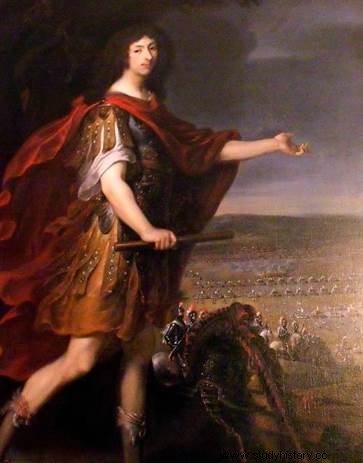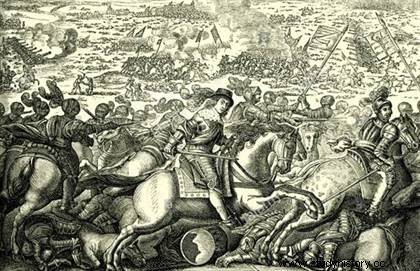 The Battle of Rocroi is a decisive French victory won by the young Duke of Enghien, future Prince of Condé, over the Spanish armies on May 18 and 19, 1643, in front of the stronghold of Rocroi. Philip IV of Spain, wanting to exploit the disappearance of Richelieu planned to invade the latter. The Spanish armies of the Netherlands, 26,000 strong, laid siege to Rocroi on May 10, in order to invest the place before marching on Paris. The French armies under the command of the Duke of Enghien, successfully undertook to clear the besieged city. The Spanish infantry lost its reputation for invincibility in this battle, the impact of which was enormous.
The Battle of Rocroi is a decisive French victory won by the young Duke of Enghien, future Prince of Condé, over the Spanish armies on May 18 and 19, 1643, in front of the stronghold of Rocroi. Philip IV of Spain, wanting to exploit the disappearance of Richelieu planned to invade the latter. The Spanish armies of the Netherlands, 26,000 strong, laid siege to Rocroi on May 10, in order to invest the place before marching on Paris. The French armies under the command of the Duke of Enghien, successfully undertook to clear the besieged city. The Spanish infantry lost its reputation for invincibility in this battle, the impact of which was enormous.
The context:the Thirty Years War
Involved at first indirectly in the Thirty Years' War which has ravaged Europe since 1618, the kingdom of France has been at war again since 1635 against Spain, whose power declining remains daunting. The alert of the capture of Corbie in November 1635 had for a moment created panic in Paris, and the war had continued with varying fortunes. But in the spring of 1643, France had just lost its “strong man”, Cardinal de Richelieu, and its king, Louis XIII, despairing of a decisive success. The new king was only five years old and when Francisco de Melo came to lay siege to Rocroi, the royal armies were headed by Louis II de Bourbon, Duke of Enghien and heir to the powerful house of Condé, which then had only twenty-three years.
 Hiding the death of Louis XIII which occurred on May 14 from his troops so as not to demoralize them, the young duke , surrounded by experienced old advisers like François de L'Hospital, advanced towards Rocroi with an army of twenty-five thousand men, determined to lift the siege. Melo, sure of the superiority of the heart of his army of Flanders, namely his Spanish and Italian tercios, disciplined infantry dominating the battlefields for a century, accepts the confrontation and deploys his troops in an enclosed plain not far from the city.
Hiding the death of Louis XIII which occurred on May 14 from his troops so as not to demoralize them, the young duke , surrounded by experienced old advisers like François de L'Hospital, advanced towards Rocroi with an army of twenty-five thousand men, determined to lift the siege. Melo, sure of the superiority of the heart of his army of Flanders, namely his Spanish and Italian tercios, disciplined infantry dominating the battlefields for a century, accepts the confrontation and deploys his troops in an enclosed plain not far from the city.
In the plain in front of Rocroi, in the Ardennes, the royal army of Louis II of Bourbon (21 years old and future Grand Condé) facing the Spanish army of Flanders of Francisco by Melo. The numbers are balanced, about twenty-five thousand men including 17,000 infantry and 8,000 cavalry in each camp. Fifteen regiments including two Swiss on the French side; about twenty including five Spanish tercios viejos and three Italian tercios in the camp of Spain...
The Battle of Rocroi
The battle starts and turns differently depending on the sector. If, on the right, the cavalry led by the young Duke of Enghien tumbles the left of the Spanish army, in the center, it is the solid tercios which take the advantage and break down the French lines which only hold thanks to the resistance. of the Baron de Sirot's reserve corps. Caught between the need to come to the aid of his routed center or to take advantage of his advantage, the future Grand Condé earned his letters of nobility as a grand captain by continuing his turning movement of the enemy army to take his right wing from behind. behind and dislocate it.
Hardly restrained from the front and threatened from behind, the solid but heavy Spanish infantry, five thousand elite soldiers under the orders of the old Count of Fuentes - four- twenty-three years old and carried in a litter! - soon finds herself threatened from all sides but faces up without batting an eyelid. Three times, Enghien tried to break it with cavalry charges which crashed against the extremely disciplined fire and the pikes of the Spaniards.
 When the Count of Fuentes falls, killed, the battle already won seems suspended and the tercios, now leaderless, ready to surrender. But the lack of confidence is such that, believing to see the preparation of a new charge where the young French general advances to receive the surrender, the Spaniards open fire again. Crying treachery, the French, encircling the tercios from all directions, launched a general assault and smashed the opposing squares. If the remnants of Melo's cavalry manage to escape, his infantry will count six thousand dead and as many prisoners.
When the Count of Fuentes falls, killed, the battle already won seems suspended and the tercios, now leaderless, ready to surrender. But the lack of confidence is such that, believing to see the preparation of a new charge where the young French general advances to receive the surrender, the Spaniards open fire again. Crying treachery, the French, encircling the tercios from all directions, launched a general assault and smashed the opposing squares. If the remnants of Melo's cavalry manage to escape, his infantry will count six thousand dead and as many prisoners.
The first French victory over a Spanish army in a century
Thus the first victory was the guarantee of many others. By winning a spectacular victory over the infantry queen of the battlefields, the French cavalry and the Duc d'Enghien, soon to be known as the Grand Condé, carved out a first-rate reputation for themselves by averting the danger of an invasion at the time even from a difficult succession. Five years later, Of these formidable tercios of the army of Flanders, Condé, five years later, on August 20, 1648, was to complete the remains in the plains of Lens.
After Rocroi, the conflict will continue for another fifteen years until the signing of the Pyrenees peace treaty. Spain definitively loses its supremacy in Europe to the benefit of the France of Louis XIV.
Bibliography
- Rocroi, 1643, by Laurent Henninger. Great Battles of History, 1993.
- Rocroi 1643, by Stéphane Thion. History and Collections, 2013.
- The Tuesday of Rocroi, by Marc Blancpain. hatchet, 1991.
